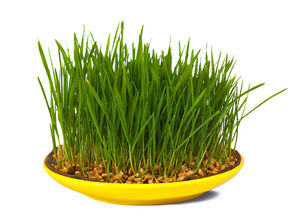
Wheat grass
Both barley grass and wheat grass are considered green super foods. Each one contains many amino acids including ones that our body cannot create, along with several vitamins and minerals. Both barely grass and what grass are rich in chlorophyll, high-quality proteins and bioactive enzymes. Naturally, both grasses have become extremely popular. The question on everybody’s minds is: “barley grass vs. wheat grass” which is better? So let’s find out which grass wins in this grass faceoff!
Taste – wheat grass wins!
As far as taste of both grasses is concerned, wheat grass is a clear winner. Barley grass has a nutty, earthy flavor which needs to be masked with other flavors. This is not the case with wheat grass. Both homegrown and commercially available wheat grass juices taste sweet and delicious and you do not have to mask its taste with other ingredients.
Nutrient content – barley grass wins!

Barley grass
Many Japanese scientists have extensively researched different kinds of grasses. Based on these studies, and according to lead researcher Yasuo Hotta of La Jolla University of California, barley grass is more superior compare to any other grass available out there. This is thanks to its P4D1 content which is not available in any other grass. His study has further shown that P4D1 can actually repair the DNA that has been damaged by radiation or cancerous cells. This is a remarkable discovery for the field of oncology, anti-aging etc.
Here are some more findings about barley grass vs. wheat grass which may put the latter to shame:
- P4D1: suppresses pancreatitis, inflammation of the oral cavity, dermatitis and also lacerations of the stomach and duodenum. Barley grass is even stronger than steroids in fighting these diseases.
- Vitamins: Both grasses are rich in various vitamins and minerals. The amounts of vitamins (percentage values) vary based on the brand you buy. In particular, you must note the different values of Vitamins A, C and K when buying any of the grasses.
- Sodium content: Organic sodium content of Barley grass is much higher than that of wheat grass. 100 grams of barley grass contains nearly 775 mg of organic sodium. This fact is very beneficial for people with tendency towards dehydration. Organic sodium also keeps a check on the calcium levels in the bloodstream and can even dissolve the stored calcium in joints. This is very calming for the nerves as well as for arthritis patients. According to K.K Fowlkes who provides fresh grass juices to people, “People with arthritis will benefit more from barley grass due to its high sodium content”. Also, regular intake of barley grass juice can replenish the lost organic sodium of the stomach and aid digestion by increasing the hydrochloric acid production in the guts.
- Cholorophyll: Wheat grass contains more chlorophyll than barley grass. However, I believe this may vary based on the brands. Always choose a brand that lists chlorophyll content.
- Protein: More and more bodybuilders and weight-watchers are known to choose barley grass over wheat grass as far as protein content and weight loss are concerned. Again, the brand of barley grass or wheat grass you select will show you’re the protein in grams. Choose accordingly.
Detoxification effects – wheat grass wins!
Detoxification effect of wheat grass is a lot stronger than Barley grass-something which many people cannot tolerate.
Barley grass vs. wheat grass – the winner is:
And the winner in barley grass vs. wheat grass is (drum roll please) Barley Grass. Clearly it has more nutrition and is proven to improve sexual stamina, skin tone, and also heal dryness of skin associated with aging. And you can always mask its bitter, nutty taste by adding some chocolate. Now who wouldn’t like that!
Tell us who you think the winner is in the comments below!

